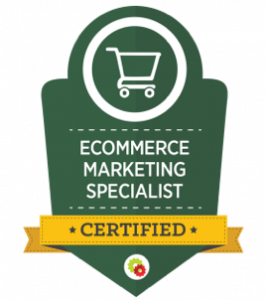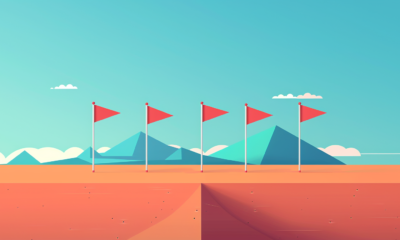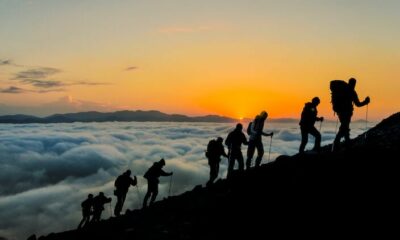MARKETING
Money Down the Drain: 5 Google Ad Mistakes You Need to Fix

Imagine you are a chef trying to cook a delicious meal. You have all the ingredients you need, but if you don’t follow the recipe correctly, your dish is likely to turn out subpar. The same is true with Google Ads. Even if you have a great product or service to offer, if you don’t set up your campaigns correctly, you’re not going to get the results you want.
After auditing literally 1000s of Google ad accounts at my agency Digital Street, even the top-spending ad accounts have one or more of these costly mistakes.
The numero uno on the list is:
1. Conversion Tracking Not Set-up Properly: The Blindfolded Marketer
Imagine walking into a labyrinth without a map or any sense of direction. That’s exactly what happens when you neglect to set up conversion tracking. Without conversion tracking, you’re merely guessing which campaigns, keywords, or ads are generating actual results. It’s like wandering in the dark, hoping for the best.
Let’s say you’re running an e-commerce business, and your goal is to drive online sales. By implementing conversion tracking, you can track and attribute sales to specific ads or keywords. Without it, you’re left unaware of which campaigns contribute to your revenue, making optimization an uphill battle.
2. Irrelevant or Excessive Keywords: The Scatterbrained Advertiser
When it comes to keyword selection, quality trumps quantity. Overloading your campaigns with irrelevant or excessive keywords will not only drain your budget but also dilute your targeting efforts. Remember, relevance is the key to capturing the attention of potential customers.

Suppose you’re promoting a luxury travel agency specializing in exotic destinations. Using keywords like “cheap flights” or “budget accommodations” would attract budget-conscious travelers, not your desired high-end clientele. Instead, focus on terms like “luxury travel packages” or “exclusive resorts” to target the right audience.
Studies indicate that narrowing down your keyword list to 10-20 highly relevant keywords can increase click-through rates by up to 200%. Quality beats quantity every time!
3. Neglecting Negative Keywords: The Wasted Impressions
Imagine if your ads were shown to people searching for something entirely different from what you offer. That’s where negative keywords come in. Failure to utilize negative keywords can result in wasted impressions, clicks, and ultimately, wasted budget.
Let’s say you’re selling premium dog food and want to target dog owners looking for healthy options. By adding “cat” as a negative keyword, you prevent your ads from showing to people searching for cat-related products. This way, you ensure your ads are displayed only to those genuinely interested in your dog food.
Including negative keywords can decrease your cost-per-click (CPC) by up to 50%, maximizing your ad spend and filtering out irrelevant clicks. Don’t let your budget go to waste!
4. Search Copy: The Bland & Boring Approach
Your ad copy is the hook that reels in potential customers. However, if it fails to engage or lacks relevance to the search query, it becomes a missed opportunity. Remember, you have a limited number of characters to captivate your audience, so make sure every word counts!
Suppose you’re running a digital marketing agency offering SEO services. Instead of a generic headline like “Best SEO Services,” try something more compelling and relevant, such as “Unlock Your Website’s Potential with Expert SEO Strategies.” This way, you immediately address the searcher’s needs and stand out from the competition.

Become A Certified E-Commerce Marketing Master
The Industry’s Most Comprehensive E-Commerce Marketing Certification For The Modern Marketer. Turn Products Into Profit, Browsers Into Buyers, & Past Purchasers Into Life-Long Customers.
Ads with a high relevance score (based on click-through rate and engagement) can lead to a 50-100% increase in ad visibility and a significant decrease in cost-per-click. Engage, captivate, and conquer!
5. Ignoring Location Settings: The Disconnected Advertiser
Picture this: You’re running a local business catering to a specific geographical area, but your ads are being displayed to people thousands of miles away. Ignoring location settings is like casting a wide net without considering the waters you’re fishing in. It’s crucial to optimize your ads to reach the right audience in the right place.
Let’s say you own a boutique coffee shop in New York City. If you neglect to set your ads to target users within a reasonable radius of your location, your ads may be shown to people in Los Angeles, London, or even Tokyo! This wasted exposure not only drains your budget but also fails to attract customers who are actually within reach of your establishment.

Studies have shown that ads with localized targeting have a 200% higher click-through rate compared to campaigns with broader targeting. By narrowing down your audience to specific locations, you ensure that your ads are seen by those who are most likely to convert into loyal customers.
MARKETING
7 Things Creators Should Know About Marketing Their Book

Writing a book is a gargantuan task, and reaching the finish line is a feat equal to summiting a mountain.
MARKETING
Being position-less secures a marketer’s position for a lifetime

On March 20, 2024, the Position-less Marketer was introduced on MarTech.org and my keynote address at Optimove’s user conference.
Since that initial announcement, we have introduced the term “Position-less Marketer” to hundreds of leading marketing executives and learned that readers and the audience interpreted it in several ways. This article will document a few of those interpretations and clarify what “position-less” means regarding marketing prowess.
As a reminder, data analytics and AI, integrated marketing platforms, automation and more make the Position-less Marketer possible. Plus, new generative AI tools like ChatGPT, Canna-GPT, Github, Copilot and DALL-E offer human access to powerful new capabilities that generate computer code, images, songs and videos, respectively, with human guidance.
Position-less Marketer does not mean a marketer without a role; quite the opposite
Speaking with a senior-level marketer at a global retailer, their first interpretation may be a marketer without a role/position. This was a first-glance definition from more than 60% of the marketers who first heard the term. But on hearing the story and relating it to “be position-less” in other professions, including music and sports, most understood it as a multidimensional marketer — or, as we noted, realizing your multipotentiality.
One executive said, phrasing position-less in a way that clarified it for me was “unlocking your multidimensionality.” She said, “I like this phrase immensely.” In reality, the word we used was “multipotentiality,” and the fact that she landed on multidimensionality is correct. As we noted, you can do more than one thing.
The other 40% of marketing executives did think of the “Position-less Marketer” as a marketing professional who is not confined or defined by traditional marketing roles or boundaries. In that sense, they are not focused only on branding or digital marketing; instead, they are versatile and agile enough to adjust to the new conditions created by the tools that new technology has to offer. As a result, the Position-less Marketer should be comfortable working across channels, platforms and strategies, integrating different approaches to achieve marketing goals effectively.
Navigating the spectrum: Balancing specialization and Position-less Marketing
Some of the most in-depth feedback came from data analytic experts from consulting firms and Chief Marketing Officers who took a more holistic view.
Most discussions of the “Position-less Marketer” concept began with a nuanced perspective on the dichotomy between entrepreneurial companies and large enterprises.
They noted that entrepreneurial companies are agile and innovative, but lack scalability and efficiency. Conversely, large enterprises excel at execution but struggle with innovation due to rigid processes.
Drawing parallels, many related this to marketing functionality, with specialists excelling in their domain, but needing a more holistic perspective and Position-less Marketers having a broader understanding but needing deep expertise.
Some argued that neither extreme is ideal and emphasized the importance of balancing specialization and generalization based on the company’s growth stage and competitive landscape.
They highlight the need for leaders to protect processes while fostering innovation, citing Steve Jobs’ approach of creating separate teams to drive innovation within Apple. They stress the significance of breaking down silos and encouraging collaboration across functions, even if it means challenging existing paradigms.
Ultimately, these experts recommended adopting a Position-less Marketing approach as a competitive advantage in today’s landscape, where tight specialization is common. They suggest that by connecting dots across different functions, companies can offer unique value to customers. However, they caution against viewing generalization as an absolute solution, emphasizing the importance of context and competitive positioning.
These marketing leaders advocate for a balanced marketing approach that leverages specialization and generalization to drive innovation and competitive advantage while acknowledging the need to adapt strategies based on industry dynamics and competitive positioning.
Be position-less, but not too position-less — realize your multipotentiality
This supports what was noted in the March 20th article: to be position-less, but not too position-less. When we realize our multipotentiality and multidimensionality, we excel as humans. AI becomes an augmentation.
But just because you can individually execute on all cylinders in marketing and perform data analytics, writing, graphics and more from your desktop does not mean you should.
Learn when being position-less is best for the organization and when it isn’t. Just because you can write copy with ChatGPT does not mean you will write with the same skill and finesse as a professional copywriter. So be position-less, but not too position-less.
Position-less vs. being pigeonholed
At the same time, if you are a manager, do not pigeonhole people. Let them spread their wings using today’s latest AI tools for human augmentation.
For managers, finding the right balance between guiding marketing pros to be position-less and, at other times, holding their position as specialists and bringing in specialists from different marketing disciplines will take a lot of work. We are at the beginning of this new era. However, working toward the right balance is a step forward in a new world where humans and AI work hand-in-hand to optimize marketing teams.
We are at a pivot point for the marketing profession. Those who can be position-less and managers who can optimize teams with flawless position-less execution will secure their position for a lifetime.
MARKETING
Profit More, Work Less: 4 Steps to Niching Down For Your Agency


Ever wonder what the most successful agencies did differently than everyone else?
Was it luck, skill, hard work, the industry they chose, or something else?
Through my consulting work at Revenue Boost, I’ve worked with and taught over 400+ agencies how to scale their business.
From this, I’ve seen consistent patterns & traits in the ones who grow effortlessly…
Versus the ones who stay stuck for years – no matter how hard they work.
One key difference in approach stuck out to me.
I’ll illustrate what this one difference was with a story.
Once upon a time…
Two marketers graduated from business school with big plans to start their own agency.
Ready to conquer the world, they started cold calling, cold emailing, and doing everything under the sun to get clients.
And although they had the SAME levels of work ethic and talent…
One of them now has an 8-figure agency.
The other one of them is still freelancing odd jobs, barely making ends meet.
What did the successful one do differently?
He took a big risk and started turning down clients and projects.
Instead of offering everything to everyone, like most agency owners…
And being a jack of all trades but a master of none…
He decided only to serve Plumbers and be the best dang’ plumbing marketer on the planet.
With a goal to make their pipeline fuller than a broken toilet pipe.


He mastered the art of niching down and realized it would be easier to be the biggest fish in a small pond.
And you should too – and in this article, you’ll learn exactly how to define your own niche.
Now it may seem scary to turn down clients…and it may feel like you’re limiting yourself by focusing on only one client-type.
But it’s exactly the opposite. You’re actually limiting yourself by being everything for everybody.
Niching Down Can Help 2x-3x Your Revenues
One of my clients Lauren ran a digital agency offering everything under the sun.
Social media, paid ads, web dev, SEO, and she offered it to clients from many different industries.
Because of this, her agency stayed stuck at $25,000 a month and she couldn’t break through.
On top of that, she and her team worked so much harder than they had to and operations were messy.
Every client needed different things, required customization, and nothing was standardized.
We sat together to audit all her past clients, and we found that Medical practices were her best clients.
They were easy to sell, stayed the longest, and gave her the least amount of headaches and complaints.
So, she changed her entire business model to ONLY service this industry.
Then, she developed a standardized offer for that industry, rather than customizing everything.
One offer, to one target market. Afterwards, she started cold emailing businesses in her niche with her new offer.
The Results?
She 2X’d her revenues and grew to $52,000 in monthly revenue in not even four months time.
All from making one simple shift. One decision that can make everything easier, and you can do the same.
See, most agency owners and marketers start out with one or two clients, and then they get referred new clients from various industries.
Before they know it, they’re marketing everything for everyone and have NO idea who their ideal client is.
The Problem with Running a Business This Way Is That It Becomes Impossible to Scale.
Every single new client requires a ton of research, thought, and brainpower.


Because each new client has different needs, it leads to having no standardized processes and systems.
Which keeps the founder stuck in the business and unable to hire a team.
The other problem that arises is acquisition.
There are hundreds of thousands of agencies on the planet, and it’s really hard to stand out.
UNLESS you specialize.
When you specialize in a niche – let’s say, SEO for plumbers…
Then you aren’t competing with every other agency on the planet. You don’t look and sound just like them anymore.
Now, you’ve created your own tiny pond in which you can be a big fish.
There are way fewer agencies that specialize in plumbers or SEO, let alone both. So, you’ve eliminated the competition with one decision.
If a plumber was looking at two agencies – one that was a general digital agency and one that specializes in helping plumbers…
They almost always choose the agency that specializes in their industry and has testimonials from people just like them.
Not to mention, it’s easier to market when you have a clear niche in mind.
You know who you’re writing your content for…
You know who to send emails and social media DMs too…
You know exactly who to target in your ads….
You know what podcasts you should get booked on
And so on and so on.
Plus, you can charge whatever prices you want. Because you aren’t compared to the hundreds of thousands of agencies out there – you have a unique offer now.
Committing to one niche makes marketing easier, it makes selling easier, and it makes scaling easier.
You only have to be good at doing 1 thing for 1 person, and you can build systems and processes around it. This way, you can hire a team to take it over and be able to work less.


Become a Certified Analytics & Data Master
At Last, You’ll Have A Powerful Analytics Dashboard That Will Help You Make Smart Business Decisions
Now how do you do it? What if you don’t know who your ideal client is?
Step 1: Audit Your Current + Past Client List.
Write down every single client you’ve ever served, and group them by niche. Industry, location, size and so on.
Once you group them together, one niche might stick out for you already as your favorite type of client.
If it doesn’t, use my 7-Point checklist and rank each niche on a 1-5 scale.
These 7 criteria points are what makes a great niche.
#1 – Total Addressable Market:
How many businesses are in this market? Is it large enough to support your bigger goals? Is the market shrinking or growing? Make sure the niche is big enough for you and that it’s not declining.
#2 – Purchasing Power
Is this market (or at least a segment of it) able to afford what you want to charge?
Think back to if you’ve received a lot of pricing objections when you’ve sold to these people in the past.
#3 – Lifetime Value
How long did these clients stay? Were they one-and-done projects or did they stay with me for eternity?
The bigger the life-time value, the more money and time you can spend to acquire a client.
If the niche typically churns in a few months or only works with you for quick, one-off projects…
Then you’ll have to spend so much energy on sales and marketing to keep the business alive.
#4 – Strong Need & Pain
Does this market have an important problem to solve, one that they have to fix? Or, is what you sell just a “nice to have”?
If the latter, it’s going to be very hard to get clients.
If they can’t live without your solution, then getting clients will be a breeze.
#5 – Desire to Solve that Pain
It’s one thing for a market to have a problem, but they must also have a desire to solve that problem.
Even if they have the need that you fulfill, that’s not enough – they also have to care about fulfilling that need.
#6 – Easy to Reach
Is the market fairly easy to find online? Can you reach them via most advertising platforms and social channels? Are their groups and communities online?
If you’re targeting businesses that are hard to reach online, you’re creating one extra barrier to your success.
Step 2: Choose 1 Niche After Ranking Each of Your Past Clients.


Tally up all the rankings and pick the 1 with the highest score.
Don’t worry about making the wrong decision.
Consider this an experiment.
You aren’t married to your new niche, you can always change back in a few months if it doesn’t work out.
Step 3: Create a Pre-Packaged Offer for Your New Niche
The whole point of niching down is to create more focus and simplicity in your business
Part of this is about WHO you sell, part of this is about WHAT you sell them.
Start out by choosing 1 problem to solve for them, and 1 solution to that problem.
List out what the deliverables will be and what you want to charge.
Keep it simple! You can build upon this later.
Step 4: Test the Waters and Go Land 5 New Clients.
Before you make any drastic changes to your business, such as letting go of clients, changing your branding and website…
Test the waters first, and verify if this new niche is the direction you want to go.
Go land another 5 clients or so, and that’ll be enough to identify if these are really our ideal clients or not.
You might think they are at first but you’ll know for sure once you serve more of them.
Wrapping Up…
You know now the problems of being a jack-of-all-trades with no clear focus.
Every new client is a ton of work and requires customization…
And getting new clients is difficult because there’s nothing that stands out about your agency. You’ll look and sound like everyone else.
This means when you do niche down, and sell 1 offer to 1 target market…
Your workload will decrease. Each new client will be easier to serve than the previous one.
You’ll become world-class at helping your clients from all the focused repetition
You’ll quickly develop a reputation and become a big fish in a small pond.
In every way, it’ll become easier to grow, scale, attract, and retain clients.
Plus, you’ll have more fun and the business will be simpler & easier to run.
And with this knowledge…
You’ve learned the 5 simple steps to niching down.
So…
Time to get to work!
Put this into practice and watch it transform your business.
-

 PPC7 days ago
PPC7 days ago86 Summer-Ready June Content Ideas
-

 MARKETING6 days ago
MARKETING6 days ago3 Contextual Link-Building Strategies That Actually Work
-

 MARKETING6 days ago
MARKETING6 days agoGoogle’s Surgical Strike on Reputation Abuse
-

 SOCIAL7 days ago
SOCIAL7 days ago12 Proven Methods to Make Money Blogging in 2024
-

 PPC5 days ago
PPC5 days agoGoogle Ads Releases New Search Partner Insights & Controls Following Advertiser Concerns
-

 PPC6 days ago
PPC6 days ago5 Campaign Red Flags And Why They Matter
-

 SEO5 days ago
SEO5 days ago14 Ways to Use AI for Better, Faster SEO
-

 SEO5 days ago
SEO5 days agoChatbots And AI Search Engines Converge: Key Strategies For SEO

















